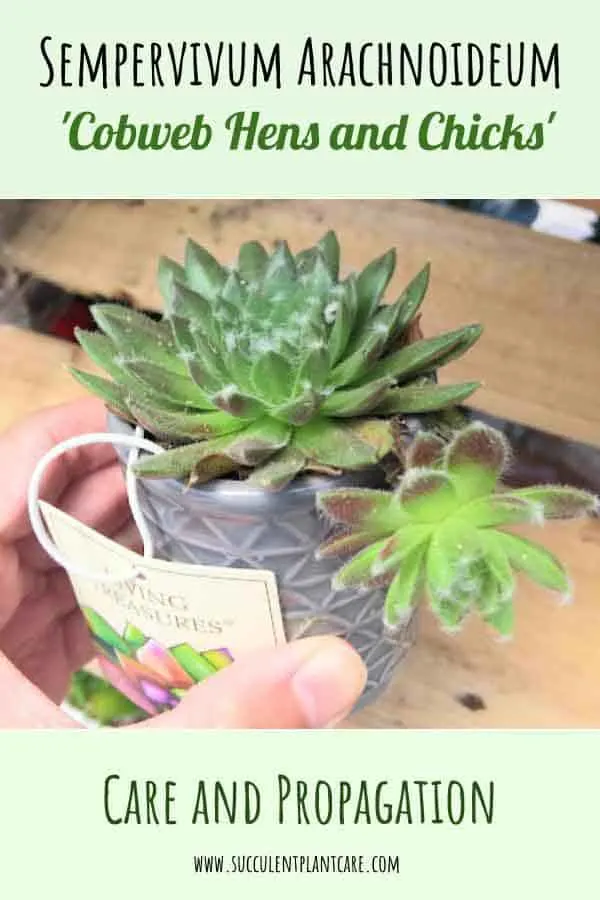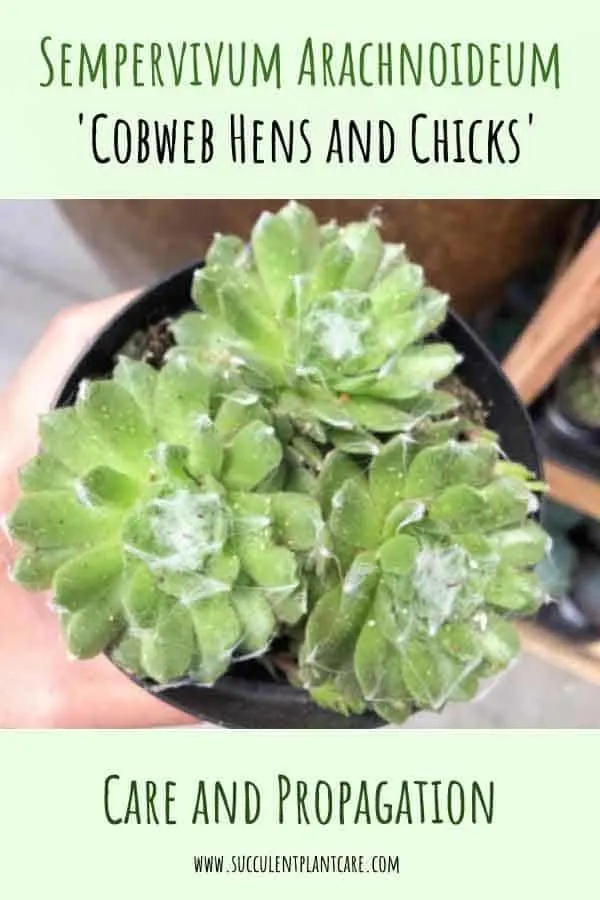Sempervivum arachnoideum ‘Cobweb Hens and Chicks’ are low-growing, clump-forming succulents with green rosettes covered in a white, hairy webbing. The plant turns purplish brown in full sun and when exposed to the cold weather. Like most sempervivums, these plants grow in clumps and spread by producing offsets and pups.
At first glance, the plant looks like it is covered in spider webs. When my husband first noticed my Sempervivum arachnoideum ‘cobweb hens and chicks’ plant, he asked me if there was something wrong with it.

He thought the plant was infested with something because of all the white webs around it. I, of course, got a kick out of his reaction. These make excellent ground covers as well as container plants due to their easy-going, adaptable nature. Learn more about care, propagation and growing tips here.
Are They Indoor or Outdoor Plants?
Sempervivum arachnoideum ‘Cobweb Hens and Chicks’ are happiest when grown outdoors where they can get the right amount of sunlight and fresh air they need. When grown indoors, make sure to provide them with some outdoor time during the warmer months to help them thrive.
USDA Hardiness Zone: Cobweb Hens and Chicks are hardy in USDA hardiness zones 5a-8b.
Indoor Lighting Requirements
When growing indoors, find the brightest spot in the house to place the plant. Choose an east facing window if possible. A south or west facing window will also work. Overwatering along with poor lighting can send the plant to an early grave. You may need to move the plant around your house a few times to find the best location where it’ll be happiest.
You will soon notice the plant elongating or stretching out if it is not receiving enough light. This process is called etiolation when the plant is stretching towards the source of light. This produces weak and stunted growth. Increase the amount of lighting if you notice your plant doing this. For areas that receive poor lighting no matter the time of the year, you may consider using a grow light. Grow lights can help supplement your plants’ lighting requirements especially during those long, dark winters. Here are some of my grow light recommendations.
To read more about this topic on indoor lighting for succulents, check out my post on “Proper Lighting for Succulents Indoors” to get some helpful tips.
Outdoor Sunlight Requirements
Sempervivum arachnoideum ‘Cobweb Hens and Chicks’ can tolerate partial shade to full sun. When exposed to full sun, the plant turns purplish brown in color. When kept in the shade, it maintains its green coloring.
To prevent sunburn or sun damage, acclimate the plant to full sun. Slowly increase the amount of sunlight it receives until it is fully acclimated to the heat of the sun. Morning sun is better tolerated than afternoon sun, so you can start with morning sun first. Keep in mind that even when the plant is already acclimated to full sun, it can still get sunburned during a heatwave or intense heat. Mature plants are more tolerant of heat than smaller plants.
Sunshades are a real lifesaver for my plants during the intense summer heat here in Northern California where the temperatures can rise above 100℉ or 37.8℃. Here are some of my recommendations for sunshades and sun protection.
For further details and information on outdoor sunlight requirements, please visit my post “How Much Sunlight Do Succulents Need Outdoors?” to get some useful tidbits.
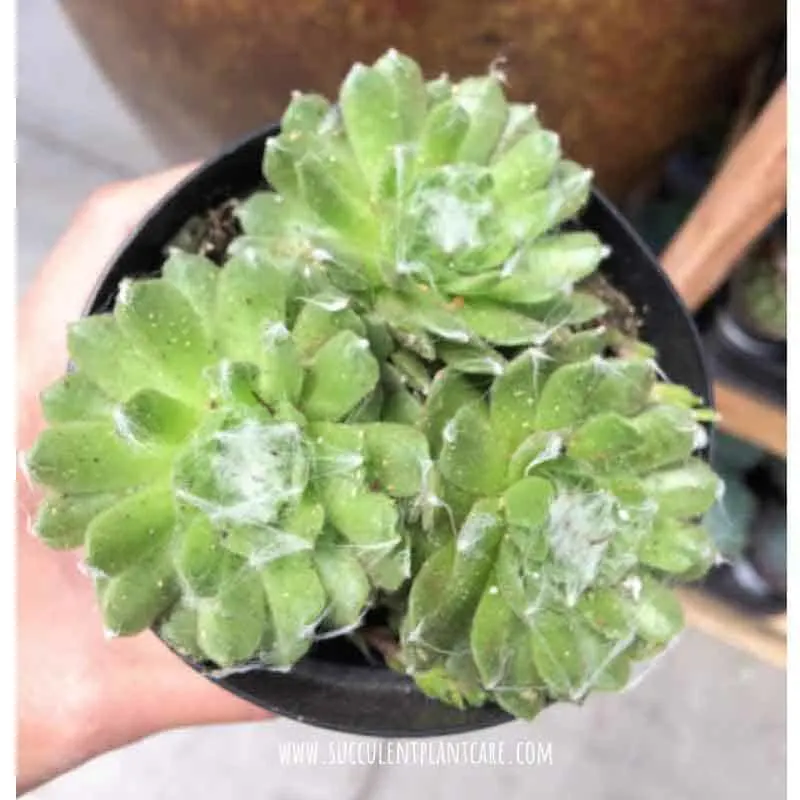
Frost Tolerance
Sempervivum arachnoideum ‘Cobweb Hens and Chicks’ can tolerate frost and freezing temperatures as low as -15℉ or -26℃. If you live in USDA hardiness zones 5-8, you can leave the plant outdoors all year long and they can even be planted in the ground. My plant stays outdoors all year long, and it survives the cold rains and occasional frost we experience in the winter months here in Northern California.
During severe winter conditions, you can protect your plants by using frost protection. You can use frost cloths or mini greenhouses to help them survive the cold winter. Here are some of my recommendations for frost protection.
For more on this topic, do check out my post on “Optimal Temperatures for Succulents to Survive and Thrive”.
Soil Requirements
Like all succulent plants, Sempervivum arachnoideum ‘Cobweb Hens and Chicks’ need well-draining soil. The right type of soil goes hand in hand with proper watering. Succulents are susceptible to root rot so a well-draining soil helps keep them alive especially if you are unsure of how to water. I have been using a simple yet effective mixture that has worked well for my plants. I use a cactus potting mix combined with perlite for added drainage. I do not use exact measurements but eyeball it to about 2:1 solution of cactus mix and perlite (1:1 solution for humid areas). You can also use sandy soil. This can be achieved by mixing cactus mix or potting soil with coarse sand (about 2:1 ratio). Or you can use a combination of all three materials mentioned (1:1:1 solution of cactus mix:perlite:coarse sand).
I get most of my materials from a local hardware store. You can also purchase them online. Here are some of my soil recommendations. To read more about soil for succulents, click on “Best Soil and Fertilizer for Succulents” to get more useful information.
Watering Requirements
Watering largely depends on the climate you live in. Although these plants are highly adapted to dry weather conditions, they do much better when given sufficient amounts of water. There really isn’t a set schedule or formula on when to water succulents. My watering schedule is dictated by the very dry climate I live in.
In the summer months, I water my Sempervivum arachnoideum ‘Cobweb Hens and Chicks’ s as often as every 7-10 days. I cut back on watering to about every 10-14 days when the weather cools down. During the winter season, I mostly rely on rainwater and hold back on watering altogether because this is when we get a lot of rain in my area. But if we don’t get any rain at all during winter then I water at least once a month or every 2-3 weeks, depending on how dry the soil gets.
Keep in mind that I live in a very dry climate. For those people in humid locations, you won’t need to water as much. And if you keep your plants indoors, you may not have to water as much especially if they are not exposed to a lot of light. Too much water and not enough light is a recipe for disaster for these plants.
One good way to tell whether it’s time to water is to check the moisture of the soil. The top inch of the soil needs to feel dry before you can water again. If you are unsure how much and how often to water in the beginning, it’s always better to underwater and increase watering as needed. Pay attention to how your plant looks and you can adjust watering accordingly.
For further help with watering techniques, consider using tools like hygrometers or moisture meters to check for moisture in the soil and air. These tools are pretty affordable and can come in handy especially if you are unsure of when to water your plant next. I have narrowed down the choices here on my resource page.
Interested in finding out more about watering succulents? Visit my post “How And When To Water Succulents” where I go into details about this topic.
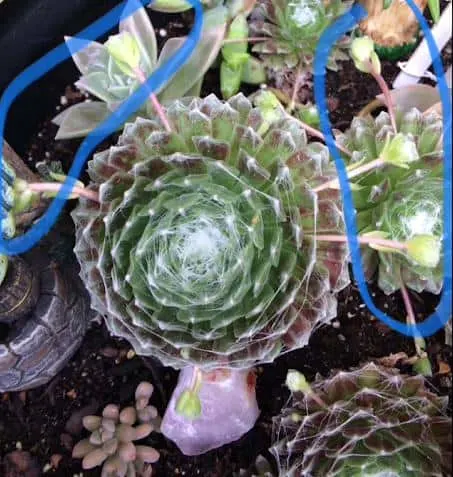
Sempervivum Arachnoideum ‘Cobweb Hens and Chicks’ offshoots
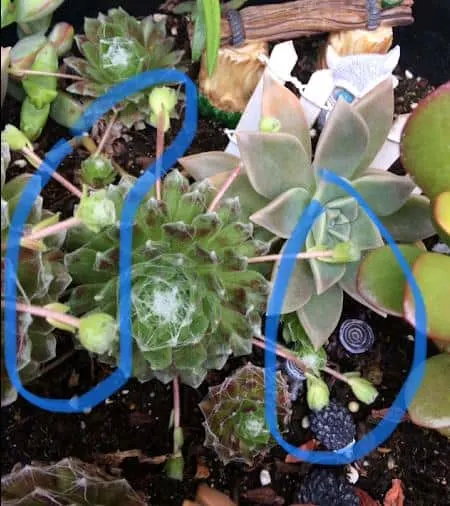
These offshoots will land in soil and root on their own to start new plants. You can also cut them off yourself and place directly in the soil to propagate.
Propagating Sempervivum arachnoideum ‘Cobweb Hens and Chicks’
Sempervivum arachnoideum ‘Cobweb Hens and Chicks’ readily produce pups and offsets. The best way to propagate these plants is by separating the pups and removing the offsets from the mother plant. Of course you’d have to wait until your plant produces pups or offshoots before you can do any propagation, but you probably won’t have to wait too long.
How to Remove Pups
- Find pups that appear large enough to be removed. Try to get some roots when removing the pup. You can remove a pup without roots, but you will have much greater success with ones that have roots already growing. Pups without roots will eventually root themselves, but the ones with existing roots have a greater chance of survival on their own. Likewise, bigger pups are stronger than smaller ones and will have a better chance of surviving on their own.
- Remove the offshoot. Some pups are easier to remove than others. Sometimes they can be separated by gently twisting the pup off the mother plant. It is better to remove the entire plant from the pot before separating the pup so you can see the roots.
- Use a clean knife. Other times you need to use a sharp tool such as a knife to remove the pup. Use a clean or sanitized knife and carefully separate the baby plant from its mother plant by inserting the knife blade between the mother plant and the offshoot. Slowly pull apart the pup from the mother plant and sever the connecting root. If removing the pup while still planted in the soil, insert the knife blade into the soil between the mother plant and the offshoot. Slide the blade down the soil to sever the connecting roots. Carve out a 2-inch radius in the soil around the base of the offshoot then dig a few inches down the radial parameter using the sharp end of a small spade. Insert the spade at an angle underneath the offshoot and carefully pry it loose from the soil to remove.
- Let the pup dry for about a day or more to make sure any cut or open areas are dry and sealed or calloused. Keep in a dry location away from direct sunlight.
- Optional: Dip the pup in rooting hormone before planting. Rooting hormones can help speed this process up especially for pups without roots.
- Plant the pup. Once the pup is dry it can be planted on its own. Prepare a suitable well-draining potting mix and plant the pup into the soil. Pack the soil lightly around the plant until secure.
- Water occasionally. Pups need a little more moisture than mature plants. Lightly mist the soil with a spray bottle every few days or when the soil feels dry. Once the plant is more established and rooted, stop misting and water more deeply. You can decrease watering to about once a week or less.
- Protect from direct sunlight. Protect new plants from direct sunlight when initially planted on its own pot to prevent sun damage. Gradually increase sunlight and sun exposure according to the plant’s needs as the plant matures.
Sempervivum Arachnoideum ‘Cobweb Hens and Chicks’ Blooms
Sempervivum Arachnoideum ‘Cobweb Hens and Chicks’ produce light pink flowers that grow from the middle of the rosettes. Like most sempervivums, Sempervivum arachnoideum ‘Cobweb Hens and Chicks’ are monocarpic, meaning they die after blooming. Also known as the bloom of death, monocarpic plants flower once and then dies. Only the plant that blooms dies, the rest of the plants surrounding the blooming plant survives and lives on as long as they don’t bloom. While it sounds tragic, it is really not as dramatic. The plant usually does not bloom until it has produced plenty of pups and offshoots so it wouldn’t have died in vain. It may take years for the plant to bloom and by then, it has already produced enough baby plants to ensure the survival of the next generation.
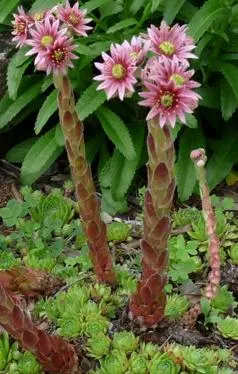
Toxicity to Cats, Dogs or Pets
Sempervivum arachnoideum ‘Cobweb Hens and Chicks’ are considered non-toxic to pets. Always proceed with caution when first introducing a new plant to house pets. If you suspect poisoning, contact your local veterinarian immediately or the ASPCA Animal Poison Control Center at 888-426-4435. Visit ASPCA’s website for more details.
Sempervivum arachnoideum ‘Cobweb Hens and Chicks’ are easygoing plants great for beginners and experts alike. They practically multiply themselves with very little help from anyone. Their unusual appearance and texture add a lot of fun and interest to any garden space.
Wondering where you can find Cobweb hens and chicks? Visit my resource page for recommendations on where to purchase these and other succulents online.
Pin this to save for later or share with others now!
